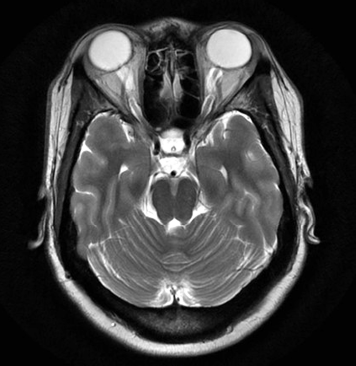Question: In children with idiopathic (or primary) intracranial hypertension (IIH)—previously called pseudotumor cerebri syndrome—are the typical patients obese as they are in the adult population with this disease?
Explore This Issue
ACEP Now: Vol 38 – No 10 – October 2019
Axial T2-weighted MRI of a patient with idiopathic intracranial hypertension shows prominent cerebrospinal fluid surrounding the optic sheaths within both orbits.
Living Art Enterprises/Science Source
Although intracranial hypertension is associated with obesity, does this connection hold true in children? Balcer et al performed a retrospective chart review of 45 consecutive children younger than 18 years old who had IIH.1 Heights and weights were recorded in 40 of these 45 patients, and obesity was defined as >120 percent of ideal body weight adjusted for age and sex. Of these 40 patients, children were divided into three age groups: 3–11 years, 12–14 years, and 15–17 years. By age group, obesity was documented in 6 of 14 (43 percent), 13 of 16 (81 percent), and 9 of 10 (90 percent), respectively, suggesting that obesity was a less common risk in children younger than 12 years of age. In older children with IIH, obesity was more common.
Another retrospective study of the Intracranial Hypertension Registry evaluated 142 pediatric primary intracranial hypertension (PIH) patients.2 Of the 142 patients, 103 (72.5 percent) were female. Patient demographics were broken down between pre-pubertal (younger than 11 years old) and post-pubertal (11 years or older). While a specific percentage of obesity was not reported in pre- versus post-pubertal groups, the average body mass index in the pre-pubertal group was 21.6 while the average in the post-pubertal group was 30.7 (which is consistent with obesity), a statistically significant finding. The authors also note that the ratio of girls to boys in the pre-pubertal group was almost even at 1 to 1.04.
A recent prospective population-based cohort study evaluated 185 newly diagnosed cases of IIH in children age 1–16 years.3 There were three demographic age categories: 4–6 years, 7–11 years, and 12–16 years. Obesity was present in 7 of 17 (41 percent) cases in the 4–6-year-old group, 29 of 58 (50 percent) cases in the 7–11-year-old group, and 84 of 110 (76 percent) in the 12–16-year-old group. This study suggests, again, that there is an association with obesity in older children with IIH but not necessarily in pre-pubertal children.
While the association between IIH and obesity is strong in older post-pubertal children, it appears less commonly associated in young children prior to puberty (typically less than 50 percent). Avoid disregarding the potential diagnosis of IIH in younger non-obese children with symptoms of the disease.
Summary
Similar to adults, in older post-pubertal children, there is a common association of IIH with obesity. In younger pre-pubertal children, though, many are not obese.
References
- Balcer LJ, Liu GT, Forman S, et al. Idiopathic intracranial hypertension: relation of age and obesity in children. Neurology. 1999;52(4):870-872.
- Aylward SC, Waslo CS, Au JN, et al. Manifestations of pediatric intracranial hypertension from the intracranial hypertension registry. Pediatr Neurol. 2016;61:76-82.
- Matthews YY, Dean F, Lim MJ, et al. Pseudotumor cerebri syndrome in childhood: incidence, clinical profile and risk factors in a national prospective population-based cohort study. Arch Dis Child. 2017;102(8):715-721.
 Dr. Jones is assistant professor of pediatric emergency medicine at the University of Kentucky in Lexington.
Dr. Jones is assistant professor of pediatric emergency medicine at the University of Kentucky in Lexington.
 Dr. Cantor is professor of emergency medicine and pediatrics, director of the pediatric emergency department, and medical director of the Central New York Regional Poison Control Center at Upstate Medical University in Syracuse, New York.
Dr. Cantor is professor of emergency medicine and pediatrics, director of the pediatric emergency department, and medical director of the Central New York Regional Poison Control Center at Upstate Medical University in Syracuse, New York.
Pages: 1 2 | Multi-Page





No Responses to “Is There a Link Between Idiopathic Intracranial Hypertension and Obesity in Kids?”